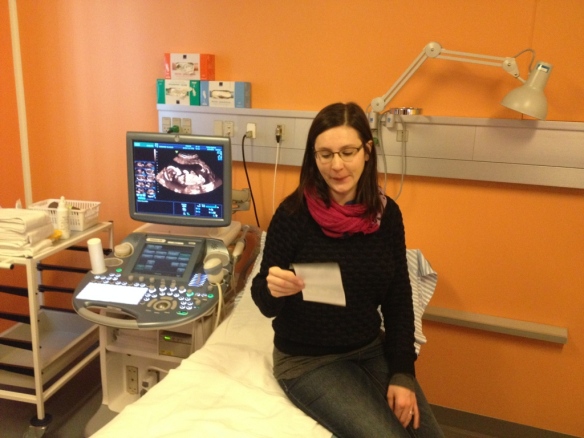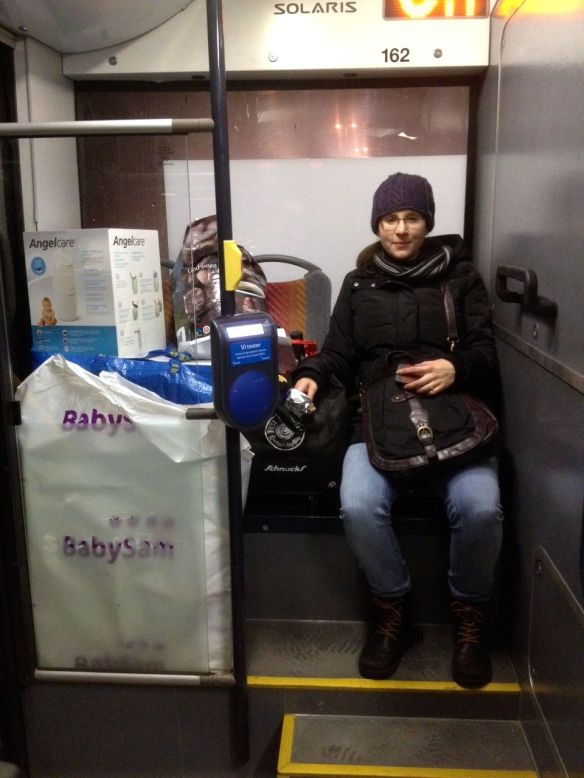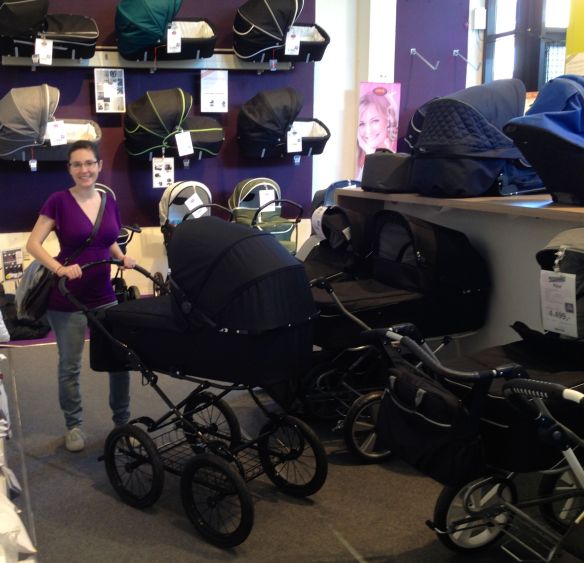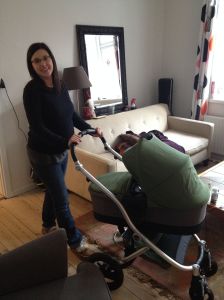This post is a little preliminary, since I actually haven’t had our baby yet! (I kind of feel like my life is stuck on one big Apple load screen and I’m just watching that little circle go around and around…) But I wanted to write something about what we were told to expect about the process of labor and delivery here in Aarhus, specifically at Skejby hospital. (Especially since if I do post something about my experience, I probably won’t feel up to it for a while!) Most of this information comes from my doctor and midwives, the prenatal classes offered by the hospital, or other moms who have been through this process. This is not actual medical advice, and I am in no way a qualified medical professional! So only know that this is how I *heard* this processes goes. Please call your midwife if you have questions or concerns.
The first thing to know about labor and delivery in Denmark is that the midwives here treat the process as something totally natural and normal, as well they should. In practice, this means that they try to let your body do what it wants/needs to do with as little intervention as possible. They also really emphasize the mother’s comfort both emotionally and physically as the best way to speed labor on.
Early Labor:
When you first feel what you consider to be labor contractions or if your water breaks, you call the midwives. They then talk to you to figure out what’s been going on and instruct you on whether you should come to the hospital yet. Usually they’ll tell you to come if you’ve had contractions that last one minute each, come REGULARLY every five minutes, and have been going on for a couple of hours.
This was a surprise for some of the dads at my prenatal classes: you DO NOT rush to the hospital as soon as you feel contractions. They usually will not admit you in Skejby unless you are in active labor, which means you are effaced 3-4cm. If you get there too early, they will tell you to go back home and come back later, and I think that often happens to first time parents.
The reason for this (apart from making sure all their beds are being used by moms in the most need) is that the midwives strongly believe that coming into the hospital will slow down your labor. There’s a new kind of expectation once you reach the hospital that things NEED TO START HAPPENING and the adrenaline rush of being anxious and scared and in unfamiliar settings will actually cause your contractions to slow down. Staying at home as long as you can will help your labor to progress more. Plus it will make your time in the hospital shorter, making your entire labor seem shorter, which can only be a good thing.
This is kind of weird for us because we don’t have a car. So getting to the hospital at the right time will take a bit more planning. We expect to take a taxi. Again, there should be plenty of time to wait and drive up there. Early stages of labor can take hours.
Your Hospital Bag:
This is what we were told to bring to the hospital:
- maternity paperwork / vandrejournal
- toiletries for your stay in the patient hotel (if it’s your first baby)
- comfortable shoes like slippers to walk around in both during labor and after the birth
- comfortable clothes for laboring in. {{They do not give you a hospital gown here. You have to bring your own clothes. Many people recommend a night gown or a long t-shirt, something that’s long enough to cover you while you’re walking around because they really encourage you to move around a lot. I actually bought a gown from Amazon that has snaps down the back and at each shoulder so that if you get an epidural you can still have the fetal heart monitor on and be covered up or you can pull the top apart for breastfeeding but still be covered up. I’m modest, OK! Let’s see if I actually end up wearing it the whole time, though.}}
- CDs if you want music.
- Baby duvet with two duvet covers. {{I do not understand the baby duvet obsession here. This may have to be a post all on its own because this rivals the giant prams in its specificity to Danish culture.}}
- Clothes for mom, baby, and partner for the days you’ll stay at the patient hotel (if it’s your first baby). They say 2-3 sets of clothes per day for baby. For mom…I’m not sure. I’m bringing a couple extra changes in case of leaking…in various places…
- Car seat or stroller for going home.
What we’re also bringing:
- Lots and lots of snacks because there’s not a lot of food for dad/partner to eat while waiting for the birth to happen and because I hear mom is often starving by the end of this whole thing and it may be the middle of the night and there’s no way Brian can just run out and get me a pizza at 11pm. This is Denmark!
- MP3 player with headphones and input cable because I may just need to block everything else out and listen to Harry Potter on audiobook or something. It’s my zen place.
- Camera with charger.
- Kindle with charger.
- iPad with charger.
- Computer with charger, maybe (the hospital does have free wi-fi).
- Breast pads and ointment, just in case.
- These crazy mesh underwear and GIANT pads for all the postpartum bleeding. They may give you these at the hospital, but I haven’t heard for sure and I don’t want to leave this up to chance.
- A going home outfit for baby including a warm fleece onesie because he’s going to be a winter baby.
Active Labor / At the Hospital:
Once you get to the hospital, a midwife will physically check your cervix to see how effaced you are and decide whether or not to admit you. Once you are admitted, you will be assigned to a birthing room and a midwife. {{Side note, you will also be offered an enema. This may surprise some of your since many countries no longer offer this as an option, finding it unnecessary. It’s still offered here I think because it eases some women’s minds and makes them less worried about pushing their hardest.}}
This is what I’m really excited about being at Skejby: they assign every midwife on duty to just one mom. So your midwife will only be worried about you and your progress rather than running around the hospital checking on her 5 other patients. That sounds awesome, and that’s also probably why doulas are not as common here as in the US. Of course, if your midwife’s shift ends she will go home. You will then be given a new midwife just coming on her shift.
Unfortunately, the midwife assigned to you probably won’t be the one you’ve been meeting with for your prenatal appointments. It will just be whoever is on duty or on call that night. (That’s the benefit of a doula, you can have someone with you that you actually know.) There is a thing they do in Skejby where you can ask to have your prenatal appointments with a group of 3 specific midwives. Then when you go into labor they will try their hardest to get one of those midwives to attend you. But we were told this is meant mostly for home births and that usually you only get one of your midwives like 75% of the time time anyway. So we opted not to do that.
{{One major aside, home births are a thing here! And a normal thing, not something where people look askance at you if you say you’re interested in one. I believe that they send a midwife to your home once you go into labor, but we didn’t investigate this option since, as first timers, we like the idea of being in the hospital in case of emergencies. And, you know, we’re renters, so it would just be…weird… But know that it’s totally an option if you’re interested.}}
Pain Maintenance:
I know what all of you are wondering about: what are my options for pain maintenance?!? This was a big concern for everyone at our prenatal classes 🙂 Again, they put a lot of emphasis on natural pain management techniques here. They believe that the pain is normal, natural, and just part of the process (in most cases). So they want you to try those as much as possible. But they do have some other pain management options. Though to me – and I think this is probably how it is everywhere, but it was just something new to me, going through this for the first time – it kind of seemed like it was massage or epidural. There aren’t too many options in between. Either you can handle the pain, or you can’t. But anyway, this is what they offer and the pros and cons that we were told for each.
Natural Pain Management Options:
- Breathing patterns: essentially remembering to breathe, doing things like deep belly breaths or the shallow puffing we all know from movies. The midwives will help to direct you on when each type is appropriate. It can be reaaaally hard to remember to breathe deeply through your contractions, so rely on your birth partner to remind you to do this.
- Moving/changing position: they are really, super into getting up and moving around through most of your labor for as long as you have the energy to do so. The midwives said it makes getting through the pain easier and it allows gravity to help. In the hospital room there are a bunch of posters on various positions you can take and use, depending on what feels comfortable to you. They also are totally OK with you laying down in various positions, especially if you’ve run out of energy from walking for however many hours you’ve already been in labor!
- Massage: this releases hormones that help to naturally reduce your pain (or increase your pain threshold, I can’t remember which!). This will be your birth partner’s responsibility. The midwife showed us a couple of different types of massage that they found useful. One, for example, was about just reminding the laboring woman that she’s not just her contracting uterus but an entire body, and it just entailed the partner lightly rubbing her shoulders and then running his/her hands down the length of her body to her ankles.
- Hypnosis: the midwife explained this option as just a way to get you to let go of the pain or fear or worries you might have. The midwife will be trained in this (usually, some are not) and can lead you through the technique.
- Water: most of the birthing rooms in Skejby have tubs. {{Yay! This is such a big difference from what I expected coming from the US, and I have to say I’m most excited about this option. I find hot water very soothing on achey muscles, so I’m hoping that we can get one when the time comes.}} They differ in size from normal tub to large hot tub size, so you can specify what you want when you call. You can also choose to give birth in the tub if you want a water birth. The only thing to know about the water is that you have to wait until you are 5-6cm dilated because it can be so effective at calming your pain it can actually slow down your contractions. Also, you can’t mix many of the medicated pain management options with the water. So if you want an epidural, the tub is not going to be an option.
- Hot/cold pads
- Acupuncture: usually they place a row of little needles along the contracting muscles to help stimulate your pain relieving hormones and endorphins and to get them to rush to that area. They tape them down so you can move around or lay down.
- Sterile water injections/”bee stings”: they will inject little drops of sterile water under your skin, also to encourage your body to release more pain relieving endorphins to the area.
Medicated Pain Management Options:
- Gas and air: I don’t think this is an option typically offered in the US, though I could totally be wrong about this, but I’ve seen on various shows that it seems to be typical in the UK. This is, I believe, nitrous oxide gas, just like the “laughing gas” you may have gotten at the dentist. You’re given an oxygen mask and breathe it in during contractions. It’s a type of medicine that quickly gets into and out of your system, so it’s only meant to help relax you through the contraction itself.
- Morphine injections: these are used very rarely these days as they can effect the baby’s breathing if used too close to birth, but it is still an option for the mom who is in serious pain.
- Local anesthetics: (ex: pudendal block) the midwife talked about using this option specifically for women who were afraid of the final pushing (perhaps because they are afraid of tearing) and so were kind of holding themselves back. It’s also used if they have to stitch you up after birth.
- Epidural: most of you probably know what this is. The big difference between an epidural in the US and one here is that here they place it so that you can still feel your legs, allowing you to get up and walk around. Also, I have heard that they turn it off when you start pushing so that you can feel the pushing and thus have a lower risk of pushing too fast and causing a big tear. The midwives were pretty good at not making you feel guilty if you know you will want an epidural immediately. They do seem to be all about the mother’s choice. But they did emphasize some of the risks involved with getting it, such as an increased risk of needing vacuum extraction (which increases your risk of tearing), etc.
Pushing / The Birth
During our prenatal appointment, I asked what position they recommended pushing in because lately you hear so much in the US about how laying down while pushing is a totally unnatural position that’s used only for the doctor’s convenience etc. etc. I found the midwife’s answer really really interesting. {{And, side note, this is why I’ve really enjoyed my experience with the midwives so far. They not only answer your question, but they tell you why they do certain things. They explain the science to you. I love that.}} She said that they had moved away from pushing while laying down but that in recent years they have encouraged laying down again because their observation has shown that it leads to less tearing (by about 1/3). This is because it allows the midwife to assist more in the birth – because she’s right there at eye level – and guide the baby out in such a way that the moms tear less. But, of course, you can give birth in any position you like, including in a tub, on a birthing stool, laying down, etc.
Just a few statistics: They use vacuum extraction to assist with births about 11% of the time with first time moms. And the midwife told us that the hospital’s c-section rate was about 21%, about half of which are planned in advance.
After the Birth
Immediately after the birth, the midwife will pop the baby up to mom’s chest so that you immediately have skin to skin contact. They will then leave the baby there for about an hour before weighing and measuring him/her. They do dry the baby off and they will take the baby to a little emergency station if they need to check on a couple of things or if there were complications. They do this skin to skin contact because it really helps with establishing bonding and breast feeding.
While you’re smelling your baby’s head and laughing and her little coos, things are still happening. You’re delivering the placenta, the midwife may be stitching up any tears, and they will be cutting the umbilical cord. We did some research into this because there’s a lot of discussion recently about how long to wait before cutting the cord. It sounds like here they cut it “within a few minutes,” which is long enough wait for the baby to get an extra rush of blood from the placenta. It is your choice if you want to wait longer, but the midwife encouraged cutting it at this time because then they can take a blood sample from the cord to determine what condition the baby was in during birth, specifically what his/her oxygen levels were. They will also give baby an injection of vitamin K to help with blood clotting and mom and injection of oxytocin to reduce hemorrhaging.
You stay in the room for about 2 hours after the birth while all of this is happening, after which you, baby, and your partner are moved to the “patient hotel.” This is basically just a long-term ward for people who need to be at the hospital but aren’t in need of any serious medical care. So it’s not just a maternity ward. You’ll have nurses checking in, but they will also be taking care of other, non-maternity patients. If this is your first child, you’re allowed a stay of 2 nights. Be warned, though. If this is your second child – even if the other was born outside of Denmark – you have to leave the hospital within a few hours if everything looks good.
Your partner can stay in the hotel with you. In fact they insist that you are not alone because it’s safer if something were to happen like you fainting or something. But your partner will need to pay for this. You should have a private room if you stay at the hotel in Skejby. If it’s full (as it can be in the summer when they typically see more births) and you have to go to a different hospital/hotel, I’m not sure if you’re guaranteed a private room. For food, you go down to the canteen (which has very Danish opening hours). Again, you are covered but your partner or other guests are not, and they advise you to bring cash.
Another biggie: the baby never goes to a nursery. He/she stays with you in your room the whole time. Good for bonding/breast feeding, maybe not so good for sleeping that first night after probably being awake for hours and hours.
The nurses are there to help you get the knack of caring for this new screaming, wriggling thing, but as they are Danish they may not volunteer a lot of information. The midwife really emphasized that we need to make sure we speak up and ask for information or if we have questions. I’m not so excited about that part. But you better believe I’ll have them check how we’re doing with breast feeding and latching and baby cleaning while we’re there. Before you leave, you have a little meeting with the nurses where they give you some quick parenting info.
Once You’re Home
A nurse will come to visit you at home a couple weeks after the birth to make sure everything is going OK. This will happen 3-4 times within the first 6 months. You will take your baby in to your normal doctor for a check-up 3 weeks after the birth, then you will have your own check up at 8-9 weeks.
Resources
Here are a few online resources that the hospital gives you. They have a lot of information about what happens here in Denmark and what to expect in general. I highly recommend perusing them if you’re curious.
- Skejby’s baby website: www.skejbybaby.dk (in Danish, but use the Chrome browser and it will translate automatically for you.) Basically, start here and click on any links that look interesting. There is A LOT of information on this website, including info on their midwives and on pregnancy in general and even on maternity leave. For example, here you can find:
- List of what to bring to the hospital
- Photo tour of the hospital and birthing rooms (in Danish)
- Info on doing a home birth
- Tryg med Barn: a website of short videos about pregnancy, birth, and after put together by the midwives in Copenhagen. You can play them in English. It’s kind of like a virtual prenatal class.






